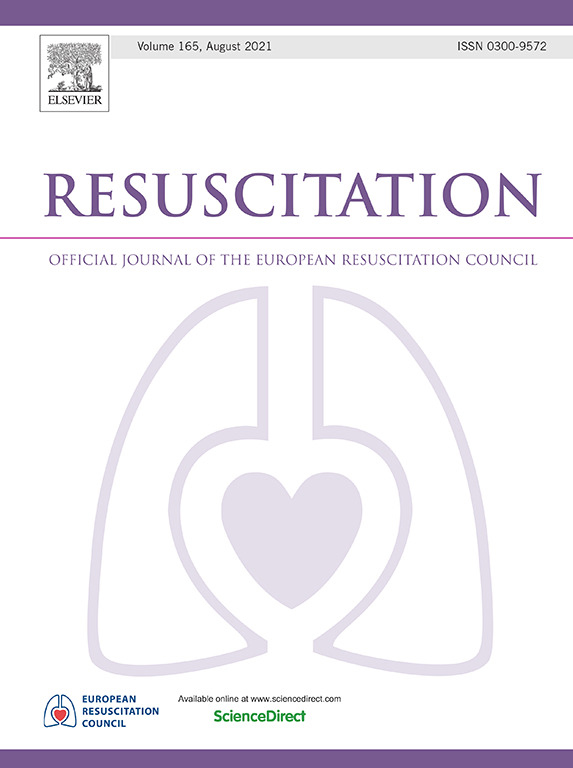Radial versus femoral access in ST-elevation myocardial infarction complicated by out of hospital cardiac arrest
IF 4.6
1区 医学
Q1 CRITICAL CARE MEDICINE
引用次数: 0
Abstract
Background
Out of hospital cardiac arrest (OHCA) is the most concerning complication of ST-elevation myocardial infarction (STEMI) and is associated with a poor prognosis. Immediate coronary angiography (CAG) and primary percutaneous coronary intervention (PCI) are recommended to restore myocardial perfusion. However, there is limited data on the preferred vascular access for these patients, who are at higher risk of both hemorrhagic and thrombotic events.
Aims
We sought to evaluate the impact of radial as compared to femoral access in the population of OHCA patients with STEMI.
Methods
This observational, single-center study prospectively included consecutive patients diagnosed with STEMI complicated by OHCA who were admitted to the catheterization laboratory between January 2007 and December 2022. The primary endpoint was a composite of in-hospital death from any cause and/or bleeding of any type and/or stent thrombosis. Propensity score matching was performed to further adjust for potential confounders.
Results
Our study included 311 patients with a mean age of 59.0 year, of whom 77.5 % were male. The primary endpoint occurred in 184 patients. Femoral access was independently associated with a higher risk of the primary endpoint compared to the radial access, both in univariate (OR = 2.36; 95 % CI [1.38–4.08]; p = 0.01) and multivariate analysis (OR = 2.25; 95 % CI [1.05–4.91]; p = 0.04). Consistent results were observed after propensity score matching (OR = 1.97; 95 % CI [1.09–3.58], p = 0.03).
Conclusion
In our analysis, femoral access was associated with a higher incidence of the primary composite outcome compared to radial access, in patients with STEMI complicated by OHCA undergoing emergent CAG.
st段抬高型心肌梗死合并院外心脏骤停的桡动脉与股动脉通路
院外心脏骤停(OHCA)是st段抬高型心肌梗死(STEMI)最令人担忧的并发症,并与不良预后相关。建议立即冠状动脉造影(CAG)和首次经皮冠状动脉介入治疗(PCI)恢复心肌灌注。然而,对于这些出血和血栓事件风险较高的患者,首选血管通路的数据有限。目的:我们试图评估在STEMI OHCA患者中桡骨通路与股骨通路的影响。方法:这项观察性单中心研究前瞻性纳入了2007年1月至2022年12月期间在导管实验室确诊为STEMI合并OHCA的连续患者。主要终点是任何原因的院内死亡和/或任何类型的出血和/或支架血栓形成。进行倾向评分匹配以进一步调整潜在混杂因素。结果:纳入311例患者,平均年龄59.0岁,其中77.5%为男性。主要终点发生在184例患者中。与桡骨入路相比,股骨入路与主要终点风险较高独立相关,两者均为单变量(OR=2.36;95% ci [1.38-4.08];p=0.01)和多因素分析(OR=2.25;95% ci [1.05-4.91];p = 0.04)。倾向评分匹配后的结果一致(OR=1.97;95% CI [1.09-3.58], p=0.03)。结论:在我们的分析中,在STEMI合并OHCA接受急诊CAG的患者中,与桡骨通路相比,股骨通路与更高的主要复合结局发生率相关。
本文章由计算机程序翻译,如有差异,请以英文原文为准。
求助全文
约1分钟内获得全文
求助全文
来源期刊

Resuscitation
医学-急救医学
CiteScore
12.00
自引率
18.50%
发文量
556
审稿时长
21 days
期刊介绍:
Resuscitation is a monthly international and interdisciplinary medical journal. The papers published deal with the aetiology, pathophysiology and prevention of cardiac arrest, resuscitation training, clinical resuscitation, and experimental resuscitation research, although papers relating to animal studies will be published only if they are of exceptional interest and related directly to clinical cardiopulmonary resuscitation. Papers relating to trauma are published occasionally but the majority of these concern traumatic cardiac arrest.
 求助内容:
求助内容: 应助结果提醒方式:
应助结果提醒方式:


